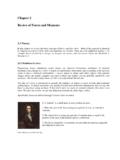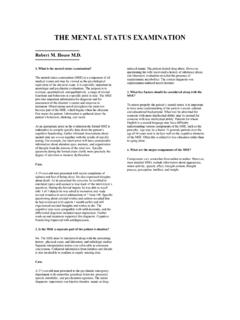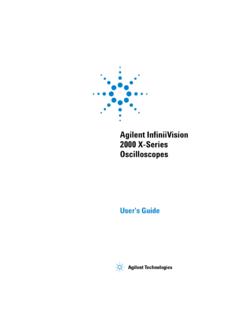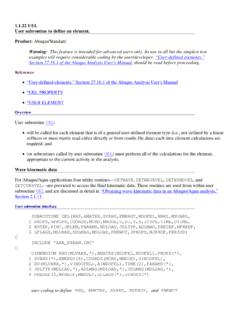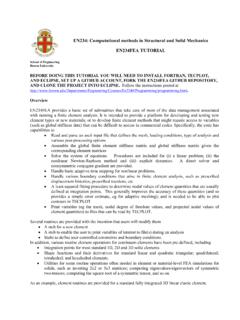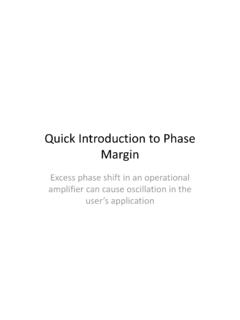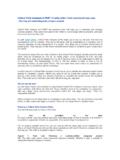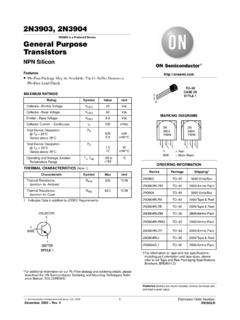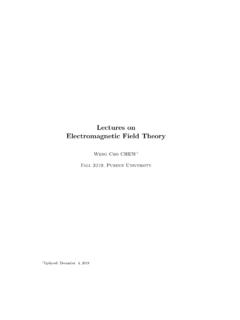Transcription of 13. Fresnel's Equations for Reflection and Transmission
1 13. Fresnel's Equations for Reflection and TransmissionIncident, transmitted, and reflected beamsBoundary conditions: tangential fields are continuousReflection and Transmission coefficientsThe " fresnel Equations "Brewster's AngleTotal internal reflectionPower reflectance and transmittanceAugustin Fresnel1788-1827 Posing the problemWhat happens when light, propagating in a uniform medium, encounters a smooth interface which is the boundary of another medium (with a different refractive index)?k-vector of the incident lightboundarynincidentntransmittedFirst we need to define some : Plane of Incidence and plane of the interfacePlane of incidence(in this illustration, the yz plane) is the plane that contains the incident and reflected of the interface (y=0, the xz plane) is the plane that defines the interface between the two materialsDefinitions: S and P polarizations2. P polarization is the parallel polarization, and it lies parallelto the plane of S polarization is the perpendicular polarization, and it sticks upout of the plane of incidenceThe plane of the interface(y=0) is perpendicular to this , the plane of incidence(z=0) is the plane of the key question:which way is the E-field pointing?
2 There are two distinct lightreflecting mediumDefinitions: S and P polarizationsThe amount of reflected (and transmitted) light is different for the two different incident that this is a different use of the word polarization from the way we ve used it earlier in this rk tk i r tEiBiErBrEtBtInterfacexyzBeam geometry for light with its electric field sticking up out of the plane of incidence ( , out of the page)We treat the case of s-polarization first:the xz plane (y = 0)Augustin fresnel was the first to do this calculation (1820 s). fresnel Equations Perpendicular E fieldnintik rk tk i r tEiBiErBrEtBtInterfaceBoundary Condition for the ElectricField at an Interface: s polarizationxyzIn other words,The Tangential Electric Field is ContinuousSo: Ei(y= 0) + Er(y= 0) = Et(y= 0)The component of the E-field that lies in the xz plane is continuous as you move across the plane of the , all E-fields are in the z-direction, which is in the plane of the interface.
3 (We re not explicitly writing the x, z, and t dependence, but it is still there.)Boundary Condition for the MagneticField at an Interface: s polarizationnintik rk tk i r tEiBiErBrEtBtInterfacexyz i i*It's really the tangential B/ , but we're using i t 0 Bi(y= 0) cos i+ Br(y= 0) cos r= Bt(y= 0) cos tThe Tangential Magnetic Field* is ContinuousIn other words,The total B-field in the plane of the interface is , all B-fields are in the xy-plane, so we take the x-components: Reflection and Transmission for Perpendicularly Polarized LightIgnoring the rapidly varying parts of the light wave and keepingonly the complex amplitudes:00 0000 cos( )cos( )cos( ) ir tiirrttEE EBB B 00000000 : () cos( )() cos( )Substituting forusing tirtir iitr itEEEEnE EnE E 000()cos() cos() ir iitttnE EnE 00 /( / )/ .But and irBEcn nEc Substituting into the second equation: Reflection & Transmission Coefficientsfor Perpendicularly Polarized Light 000000()cos()()cos() : cos( )cos( )cos( )cos( )iriitritriittiiittnE EnE EEnnEnn Rearrangingyields 00/2 cos( ) /cos( )cos( )tiiiiitttEE nnn 00/, istransmission coefficientAnalogously, the , tiEE 00/cos( )cos( ) /cos( )cos( )riiittiittrEE nnnn 00/ Solving for yields treflection coefficienthe :riEEThese Equations are called the fresnel Equationsfor perpendicularlypolarized (s-polarized) rk tk i r tEiBiErBrEtBtInterface fresnel Equations Parallel electric fieldxyzBeam geometryfor light with itselectric fieldparallelto the plane of incidence( , in the page)Note that the reflected magnetic field must point into the screen to achieve for the reflected wave.
4 The x with a circle around it means into the screen. EB k Note that Hecht uses a different notation for the reflected field, which is confusing!Ours is better!This leads to a difference in the signs of some , the case of P polarization: Reflection & Transmission Coefficientsfor Parallel Polarized LightThese Equations are called the fresnel Equationsfor parallelpolarized (p-polarized) light. ||00/cos( )cos( ) /cos( )cos( )riittiittirE E nnnn ||00/2 cos( ) /cos( )cos( )tiiiittitEE nnn Solving for E0r/ E0iyields the Reflection coefficient,r||:Analogously, the Transmission coefficient, t||= E0t/ E0i, isFor parallel polarized light, B0i B0r = B0tandE0icos( i) + E0rcos( r) = E0tcos( t)To ||cos( )cos( )cos( )cos( ) ittiittinnrnn ||2cos()cos( )cos( ) iiittintnn 2cos()cos( )cos( ) iiiittntnn cos( )cos( )cos( )cos( ) iittiittnnrnn s-polarized light:p-polarized light:And, for bothpolarizations: sin( )sin( ) iittnn plane of incidenceincident wavetransmitted waveinterfaceplane of incidenceincident wavetransmitted waveinterfaceE-field vectors are vectors are Coefficients for an Air-to-Glass InterfaceIncidence angle, iReflection coefficient, ||r 0 30 60 90 The two polarizations are indistinguishable at = 0 Total Reflection at = 90 for both 1 < nglass s angler||=0!
5 Zero Reflection for parallel polarization at: Brewster's angle The value of this angle depends on the value of the ratio ni/nt: Brewster= tan-1(nt/ni)Sir David Brewster1781 - 1868 For air to glass (nglass= ), this is .Incidence angle, iReflection coefficient, ||r 0 30 60 90 Brewster s angleTotal internal reflectionCriticalangleCriticalangleTota l internal reflectionabove the "critical angle" crit sin-1(nt/ni) for glass-to-airnglass> nair(The sine in Snell's Law can't be greater than one!) Reflection Coefficients for a Glass-to-Air obligatory java (R)R Reflected Power / Incident PowerrriiIAIA Because the angle of incidence = the angle of Reflection , the beam s area doesn t change on , nis the same for both incident and reflected Area20002cInE iwinint rwi2Rr So:since20220 riErETransmittance (T)ttiiIAIA A= Area20002cInE cos( )cos( )tttiiiAwAw t iwiwtnintIf the beam has width wi:200200222000022tttt ttttttiiiiiii iiicnEnE wIAwnwTtcIAwnwnE wnE The beam expands (or contracts) in one dimension on 2coscosttiinTtn T Transmitted Power / Incident PowerReflectance and Transmittance for anAir-to-Glass InterfaceNote that it is NOT true that: r+ t= , it is ALWAYS true that.
6 R + T = 1 Perpendicular polarizationIncidence angle, 30 60 90 RTParallel polarizationIncidence angle, 30 60 90 RTBrewster s anglePerpendicular polarizationIncidence angle, 30 60 90 RTReflectance and Transmittance for aGlass-to-Air InterfaceParallel polarizationIncidence angle, 30 60 90 RTNote that the critical angle is the same for both still, R + T = 1 Reflection at normal incidence, i= 02 titinnRnn 24titinnTnn When i= 0, the fresnel Equations reduce to:For an air-glass interface (ni= 1and nt= ),R= 4% and T= 96%The values are the same, whichever direction the light travels, from air to glass or from glass to 4% value has big implications for photography. lens flare Windows look like mirrors at night (when you re in a brightly lit room).One-way mirrors (used by police to interrogate bad guys) are just partial reflectors (actually, with a very thin aluminum coating).Disneyland puts ghouls next to you in the haunted house using partial reflectors (also aluminum-coated one-way mirrors).
7 Smooth surfaces can produce pretty good mirror-like reflections , even though they are not made of you ve seen fresnel s Equations in actionOptical fibers only work because of total internal s Equations in opticsR= 100%R= 90%Laser medium0% Reflection !0% Reflection !Many lasers use Brewster s angle components to avoid reflective losses.
